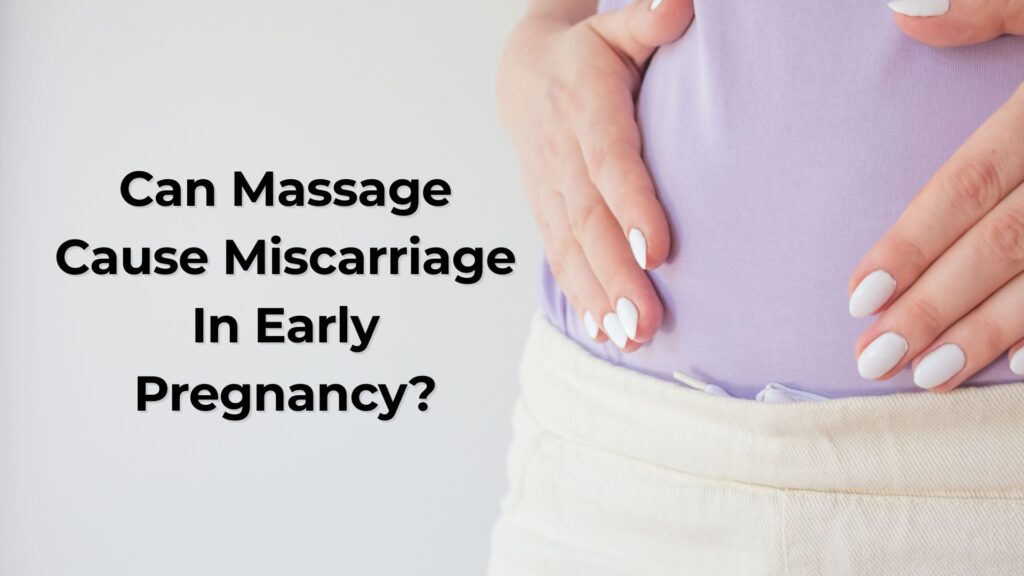Massage is a great way to relax, ease stress, and help with sore muscles. But if you’re pregnant, especially in the first few months, you might wonder if it’s safe or if it could cause a miscarriage.
Pregnancy in the first trimester is a sensitive time because your body is going through many changes. Hormones are shifting, blood flow is increasing, and your uterus is very delicate. Some types of massage, like deep pressure, acupressure on certain points, or heat therapy, could cause contractions or affect circulation.
Even though there is no clear scientific proof that massage causes miscarriage, some massage techniques can be risky if done incorrectly or on sensitive areas. Knowing which types of massage are safe and which ones to avoid can help keep you and your baby healthy.
In this article, we’ll talk about whether massage is safe in early pregnancy, which techniques to stay away from, and what precautions you should take.
What Type of Massage Should Be Avoided in Early Pregnancy?
Massage can be a wonderful way to relax, but during early pregnancy, certain techniques should be avoided to ensure the safety of both the mother and the developing baby. While massage is generally considered safe when done correctly, some methods can pose risks due to increased blood circulation, hormonal changes, and sensitivity in the uterus.
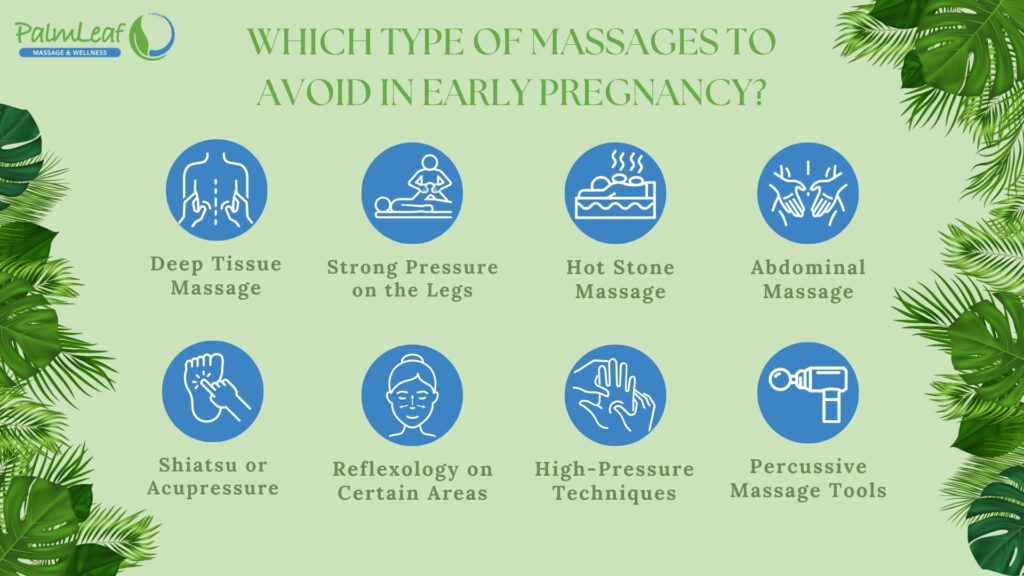
Massage Techniques to Avoid
Deep Tissue Massage
Deep pressure can affect circulation and blood pressure, potentially leading to dizziness or discomfort. It may also stimulate pressure points linked to uterine contractions, increasing miscarriage risks in early pregnancy.
Hot Stone Massage
Heat therapy, including hot stone massages, can raise the body’s temperature, similar to the effects of hot tubs or saunas. High temperatures may be harmful to the baby and are best avoided during pregnancy.
Pressure on the Legs
Pregnancy increases the risk of blood clots, particularly in the legs. Applying deep pressure could potentially dislodge a clot, leading to serious complications.
Abdominal Massage
Direct pressure on the abdomen is discouraged in early pregnancy as the uterus is still adjusting to fetal development. Any intense pressure in this area could cause discomfort or stress on the growing baby.
Shiatsu or Acupressure
Certain acupressure points, like those around the ankles (SP6) and hands (LI4), are believed to trigger uterine contractions. While scientific evidence is limited, it’s best to avoid any techniques that may stimulate early labor.
Targeted Reflexology
Reflexology is often used to relieve stress, but some foot reflexology points are believed to correspond with the uterus and pelvis. While the risks are not well-documented, erring on the side of caution is advisable.
High-Pressure Techniques and Percussive Tools
Vibrational or percussive massage tools can overstimulate muscles and nerves, leading to unnecessary stress on the body. These methods are not recommended for expectant mothers.
Safe Alternatives for Prenatal Massage
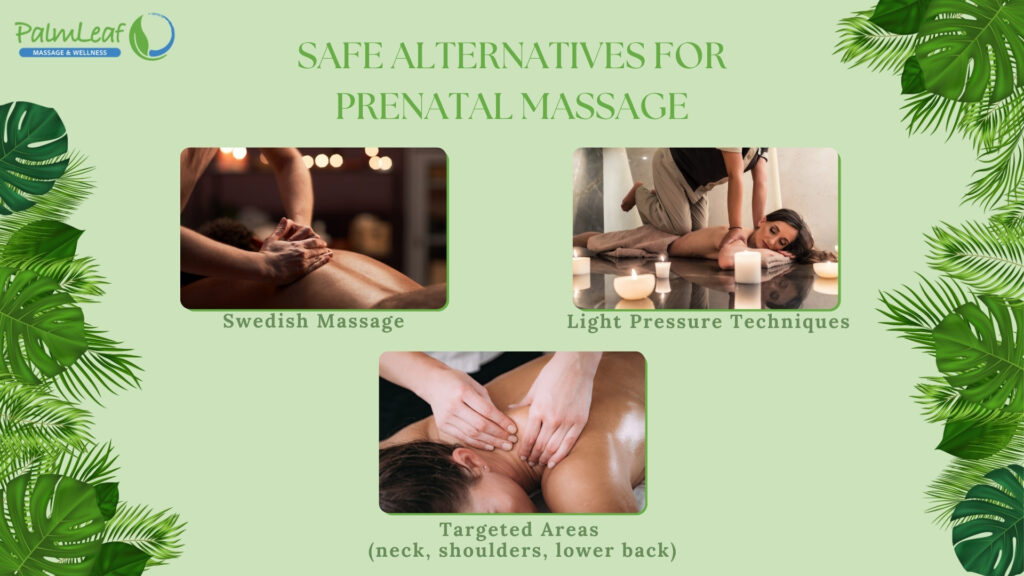
If you’re considering a massage during early pregnancy, opting for gentle techniques is the best approach. Here are some safe alternatives:
- Swedish Massage: Uses light, flowing strokes that improve circulation and reduce tension.
- Light Pressure Techniques: Gentle strokes on the legs and abdomen without deep pressure.
- Targeted Areas: Focus on the neck, shoulders, and lower back for stress relief.
Precautionary Measures for a Safe Experience
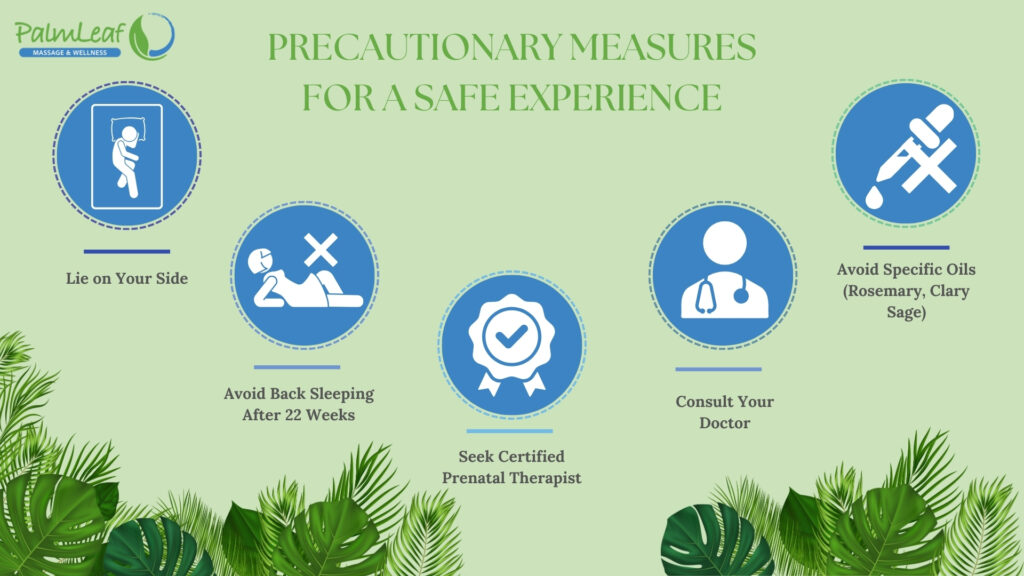
- Lie on Your Side: This reduces pressure on the abdomen and allows for better circulation.
- Avoid Lying on Your Back After 22 Weeks: Lying flat can compress the vena cava, a major vein that supplies blood to the heart.
- Seek Our Certified Prenatal Therapist: Our trained professional will understand the safest techniques to use during pregnancy which is known as Prenatal Massage.
- Consult Your Doctor: Always check with your healthcare provider before getting a massage, especially if you have a high-risk pregnancy.
- Avoid Certain Essential Oils: Some oils, like rosemary and clary sage, may not be safe during pregnancy. Always verify before use.
While massage can provide relief from pregnancy-related aches and stress, choosing the right technique is key to ensuring safety. Avoiding deep pressure, heat therapy, and targeted pressure points can help reduce risks while still allowing you to enjoy relaxation.
How Massage Affects Pregnancy in Early Stages?
Pregnancy brings about significant changes in the body, especially in the first trimester. These changes prepare the body to support the growing baby, but they can also create discomforts like nausea, fatigue, and muscle tension. Understanding these shifts helps in determining whether massage is beneficial or risky during early pregnancy.
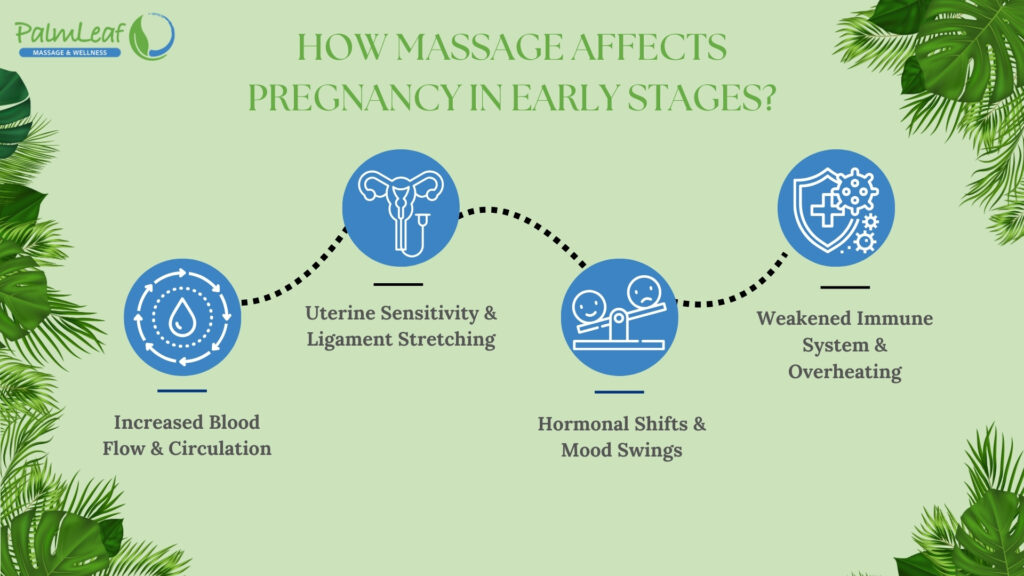
Increased Blood Flow and Circulation
- What Happens? Blood volume increases by nearly 50% to provide essential nutrients and oxygen to the placenta and fetus. This expansion causes blood vessels to dilate, leading to increased circulation but also heightened sensitivity to pressure.
- How Massage Helps? Light massage can improve blood flow, reduce swelling, and ease tension in the legs and back.
- Potential Risks: Applying deep pressure on the legs may dislodge blood clots, which are more likely to form during pregnancy. Overstimulating circulation can also lead to dizziness or discomfort.
Uterine Sensitivity and Ligament Stretching
- What Happens? As the uterus expands and its blood supply grows, the surrounding ligaments stretch, causing pelvic pain or discomfort.
- How Massage Helps? Gentle techniques on the lower back and hips may relieve tension and support the body’s adjustments.
- Potential Risks: Strong pressure on the lower back or abdomen can irritate uterine ligaments, potentially triggering mild contractions or discomfort.
Hormonal Shifts and Mood Swings
- What Happens? Pregnancy hormones like progesterone and relaxin loosen joints and ligaments, making the body more flexible but also less stable. Meanwhile, hCG (human chorionic gonadotropin) and estrogen increase, leading to nausea, fatigue, and emotional shifts.
- How Massage Helps? Massage can lower cortisol (the stress hormone) while increasing serotonin and dopamine, promoting relaxation and improving mood.
- Potential Risks: Overstimulation from prolonged or intense massage could cause fatigue or lightheadedness, overwhelming the body rather than providing relief.
Weakened Immune System and Overheating
- What Happens? The immune system slightly weakens to prevent the body from rejecting the fetus, making pregnant women more susceptible to fatigue or overheating.
- How Massage Helps? A calming massage can boost relaxation and reduce stress, helping with sleep and overall well-being
- Potential Risks: Heat-intensive therapies like hot stone massage or saunas can dangerously raise body temperature, increasing the risk of neural tube defects in the baby.
What are the Risks of Massage in Early Pregnancy?
While massage has clear benefits, certain techniques should be avoided to prevent unnecessary risks.
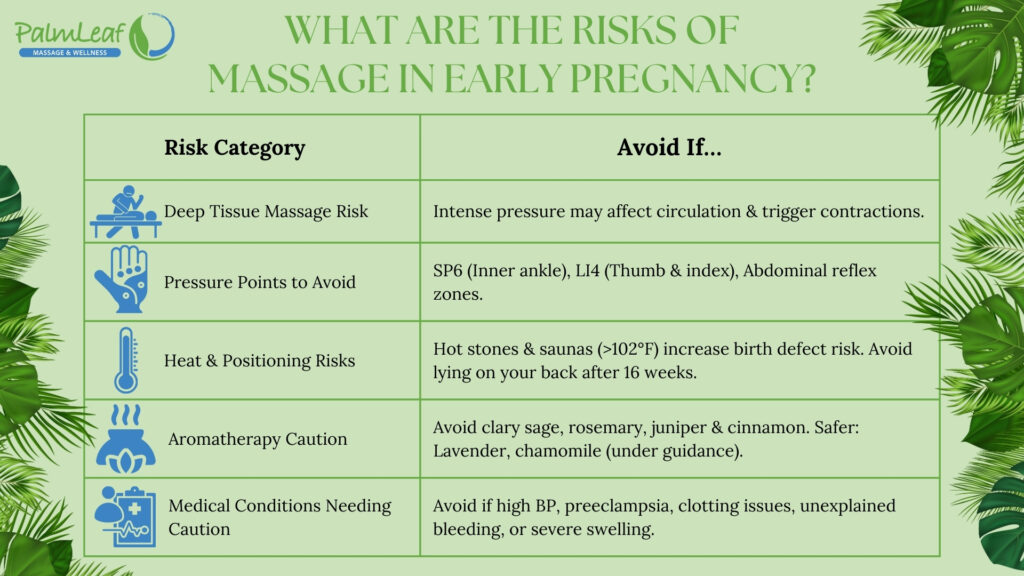
Deep Tissue Massage Risk: Intense pressure can affect blood circulation and stress sensitive muscles and ligaments, potentially leading to discomfort or even triggering uterine contractions.
Pressure Points that may cause Contractions
- SP6 (Sanyinjiao): Found above the inner ankle, this point is traditionally linked to stimulating uterine contractions and should be avoided.
- LI4 (Hegu): Located between the thumb and index finger, this point is sometimes associated with labor induction.
- Abdominal Reflexology Zones: Certain areas on the feet (heel and arch) are thought to be connected to the uterus and should be approached with caution.
Heat and Positioning Risks
- Hot Stone Massage & Saunas: Raising core body temperature above 102°F (38.9°C) can increase the risk of birth defects.
- Supine Positioning (Lying on the Back): After 16 weeks, lying flat can compress the vena cava, reducing blood flow to the heart. Some experts recommend avoiding this position even earlier.
Aromatherapy Caution
Some essential oils should be avoided in pregnancy, as they may stimulate contractions or affect hormone levels:
- Avoid: Clary sage, rosemary, juniper, and cinnamon.
- Safer Options: Lavender, chamomile, and ylang-ylang (always used in moderation and under professional guidance).
Medical Conditions That Require Extra Caution
Pregnant women should avoid massage if they have:
- High blood pressure or preeclampsia
- A history of blood clots or clotting disorders
- Unexplained bleeding or cramping
- Recent injuries, surgeries, or organ transplants
- Severe swelling or signs of fluid retention
What Pressure Points Can Trigger Miscarriage during Pregnancy?
Pressure points, commonly used in acupuncture and reflexology, are specific areas on the body that are believed to influence different organs and bodily functions. While massage and acupuncture can provide many benefits, certain pressure points are traditionally considered risky during pregnancy because they may stimulate uterine contractions, potentially leading to miscarriage or preterm labor.
It’s important to note that while traditional Chinese medicine (TCM) and reflexology caution against stimulating certain points, modern research suggests that acupuncture, when performed by trained professionals, does not necessarily lead to miscarriage. However, for safety reasons, many healthcare providers and prenatal massage therapists advise avoiding these pressure points during pregnancy.
Pressure Points to Avoid During Pregnancy
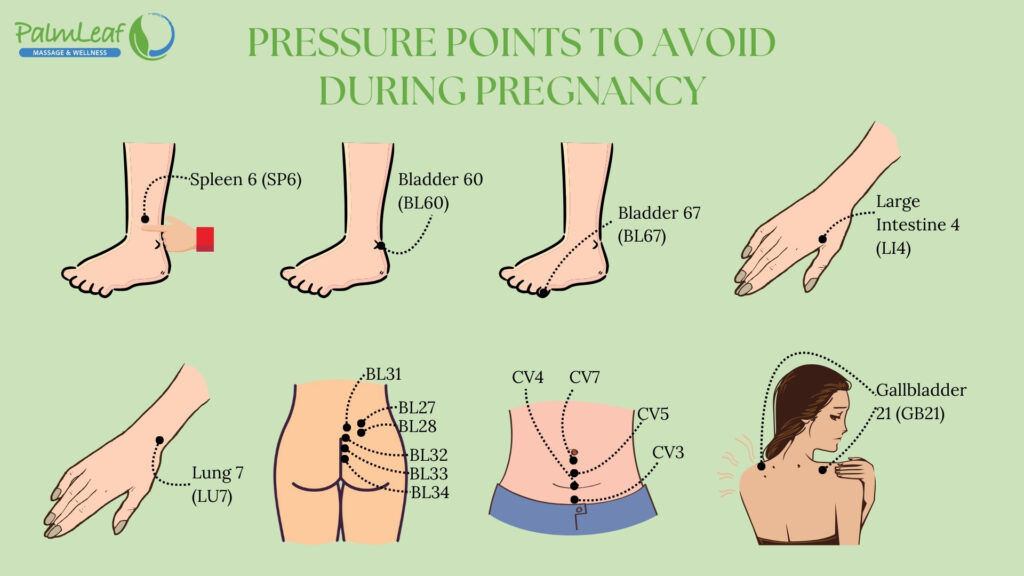
- Spleen 6 (SP6) – Sanyinjiao: About three finger-widths above the inner ankle. This point is linked to the uterus and reproductive system. It is believed to influence menstrual cycles, labor induction, and uterine contractions, making it a point to avoid during pregnancy, especially in the early months.
- Large Intestine 4 (LI4) – Hegu: In the webbing between the thumb and index finger. This pressure point is often used to relieve pain and induce labor in overdue pregnancies. Stimulating it may increase uterine activity and contractions, which is why it’s best avoided early in pregnancy.
- Bladder 60 (BL60) – Kunlun: Behind the ankle, between the Achilles tendon and the outer ankle bone. This point is associated with stimulating labor and easing difficult childbirth. Because of its potential to encourage contractions, it should not be pressed during pregnancy.
- Bladder 67 (BL67) – Zhiyin: At the outer corner of the little toenail. This point is used in acupuncture to turn breech babies and induce labor. Since it may stimulate contractions, it is best avoided in early pregnancy.
- Gallbladder 21 (GB21) – Jianjing: On the shoulder, midway between the neck base and the tip of the shoulder. This point is believed to encourage downward energy, which could stimulate uterine contractions and should be avoided.
- Lung 7 (LU7) – Lieque: On the forearm, near the wrist. Though commonly used for respiratory issues, this point is also linked to uterine activity and is traditionally avoided during pregnancy.
- Lower Abdomen Points (CV3-CV7 – Conception Vessel, BL27-BL34 – Sacral Region) Lower abdominal area and sacrum (lower back). Stimulating these points is thought to affect uterine contractions and may pose risks during pregnancy.
Should You Avoid Acupuncture and Massage Entirely?
No, not all massage or acupuncture techniques are unsafe during pregnancy. Many pregnant women benefit from prenatal massage and acupuncture when done by professionals who specialize in prenatal care. The key is to avoid the specific pressure points that could stimulate uterine contractions.
Here are some safe alternatives:
- Prenatal massage with gentle pressure techniques.
- Swedish massage, which improves circulation and relieves muscle tension without deep pressure.
- Acupuncture from Our certified prenatal specialist, who knows which points to avoid.
Is Foot Massage Safe During Early Pregnancy?
Many pregnant women wonder if getting a foot massage is safe, especially in the early months. The good news is that foot massages are generally safe during all stages of pregnancy, including the first trimester, as long as they are performed gently and correctly.
Foot massages can provide several benefits, including relieving pain, reducing stress, improving circulation, and reducing swelling. However, there are important precautions to take to ensure safety, particularly when it comes to pressure points in the feet and ankles that are believed to be linked to uterine contractions.
Benefits of Foot Massage During Pregnancy
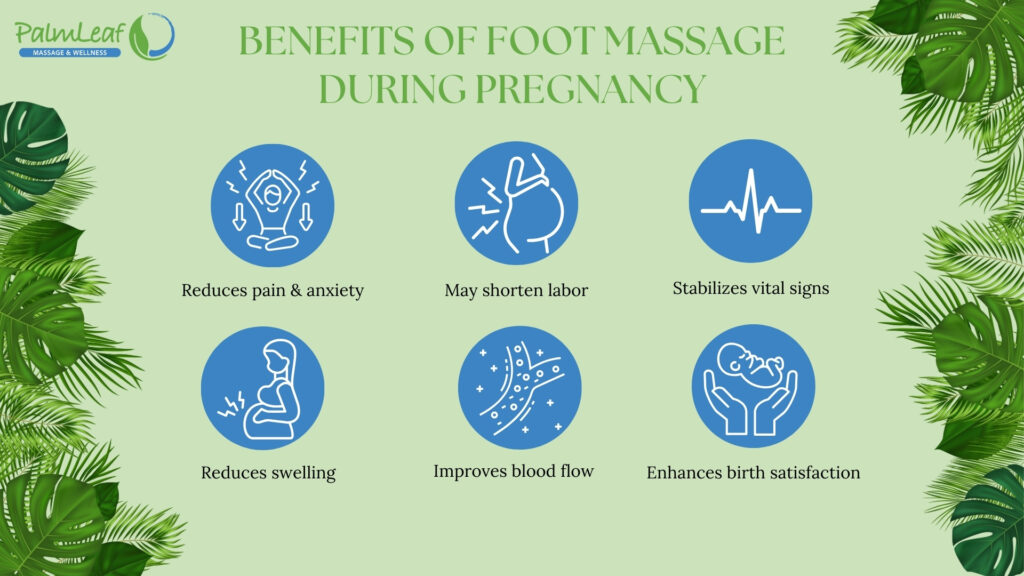
Foot massages can be a wonderful way to relax and relieve discomfort during pregnancy. Some of the key benefits include:
- Reduces pain and anxiety: Pregnancy can be stressful, and foot massages can help lower stress hormones and increase feel-good hormones like serotonin and dopamine.
- May shorten labor: Some studies suggest that relaxation techniques, including foot massages, can help promote a smoother labor experience.
- Can stabilize vital signs: Foot massage has been shown to help regulate heart rate and blood pressure, promoting overall well-being.
- Reduces swelling (edema): Pregnancy can cause fluid retention, especially in the feet and legs. A gentle massage can help reduce swelling by improving circulation.
- Improves blood flow: Foot massage encourages better circulation, helping blood return to the heart, which is especially important as pregnancy puts extra strain on the circulatory system.
- Enhances birth satisfaction: Many women report feeling more comfortable and positive about their pregnancy and labor experience when they incorporate massage therapy into their routine.
When to Get a Foot Massage during Pregnancy?
Foot massages are generally safe throughout pregnancy, but they are often most appreciated in the second and third trimesters when swelling and leg pain become more noticeable. However, if you enjoy foot massages in early pregnancy and they help with relaxation, there is no reason to avoid them as long as they are done safely.
What a Pregnant Mom Precautions Should Take?
While foot massages offer many benefits, there are some precautions that should be taken to ensure they remain safe:
- Avoid deep pressure on certain areas: Pressure points around the ankles, inner leg, and arch of the foot are believed to be linked to uterine contractions. While there is no strong scientific proof that these trigger labor, it’s best to avoid applying deep pressure in these areas.
- Be gentle on swollen feet: If you experience severe swelling, avoid strong pressure, as this may affect circulation or cause discomfort.
- Choose Our trained prenatal massage therapist: Choose a therapist who is certified in prenatal massage. When booking a professional massage, make sure your therapist is specially trained for prenatal care just like our experts at Palm Leaf Massage.
- Stop if it feels uncomfortable: Always listen to your body. If a massage feels painful or uncomfortable, ask your partner or therapist to adjust their technique.
What Trimester Should You Not Get a Massage?
Pregnancy brings many physical changes, and massage can be an excellent way to relieve stress, reduce swelling, and improve overall well-being. However, not all stages of pregnancy are the same, and special care should be taken when considering a massage during the first trimester.
First Trimester (Weeks 1-12): Why Caution is Advised?
The first trimester is a critical time in fetal development, as the embryo undergoes rapid changes and organ formation. While there is no scientific evidence proving that massage can cause miscarriage, healthcare providers often recommend postponing non-essential massages during this stage as an extra precaution.
Why Some Experts Advise Against Massage in the First Trimester?
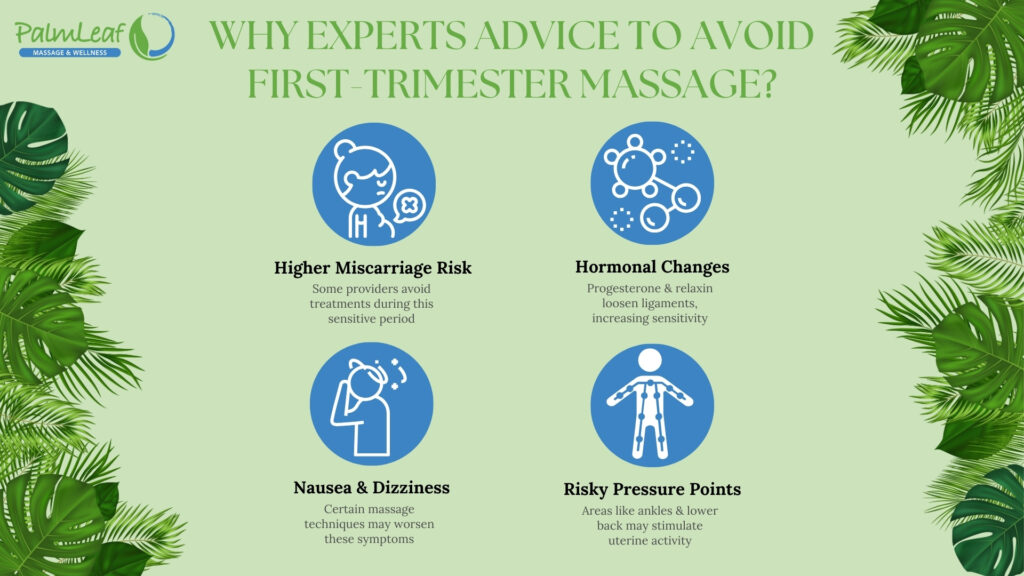
- The risk of miscarriage is naturally higher in the first trimester, so some providers prefer to avoid any unnecessary treatments.
- Pregnancy hormones, particularly progesterone and relaxin, cause the ligaments to loosen, making the body more sensitive to external pressure.
- Nausea and dizziness are common during the first trimester, and certain massage techniques may intensify these symptoms.
- Some pressure points, such as those around the ankles and lower back, are traditionally associated with stimulating uterine activity.
When Is Massage Safe in the First Trimester?
If a massage is necessary, it should be:
- Performed by a licensed prenatal massage therapist who understands pregnancy-specific precautions.
- Approved by a healthcare provider, especially for high-risk pregnancies.
- Gentle and relaxing, avoiding deep pressure or heat therapies.
Second and Third Trimesters: When Massage Becomes More Beneficial?
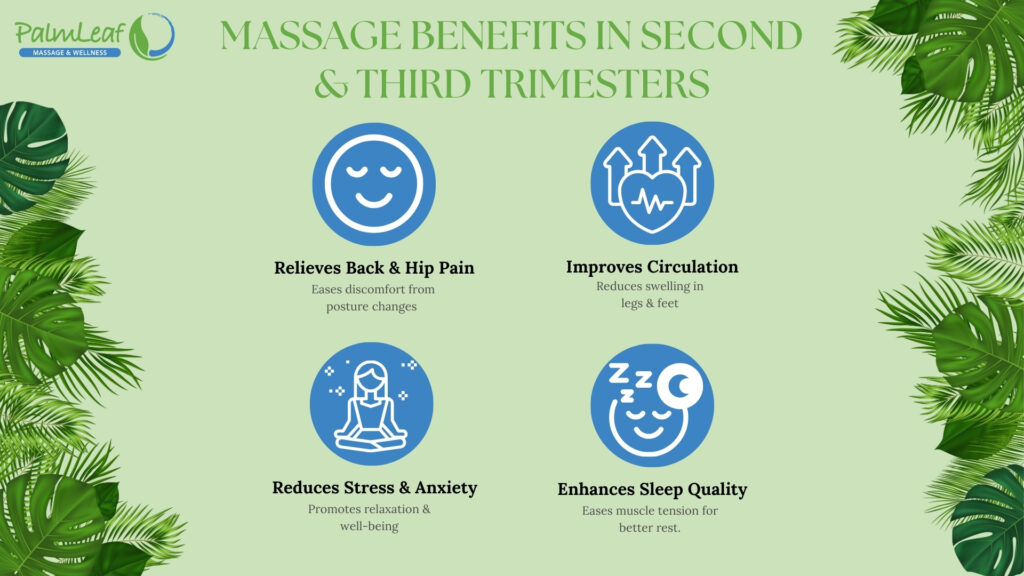
After the first trimester, prenatal massage is generally considered safe and even highly recommended for relieving pregnancy-related discomfort. As the body adjusts to the growing baby, massage can help with:
- Reducing back and hip pain caused by postural changes.
- Improving circulation to decrease swelling in the legs and feet.
- Easing stress and anxiety by promoting relaxation.
- Helping with sleep by reducing muscle tension and discomfort.
However, during the later stages of pregnancy, massage should be performed with proper positioning to avoid pressure on the abdomen. Many professionals recommend side-lying positions for comfort and safety.
Why Choose PalmLeafMassage for Prenatal Care?
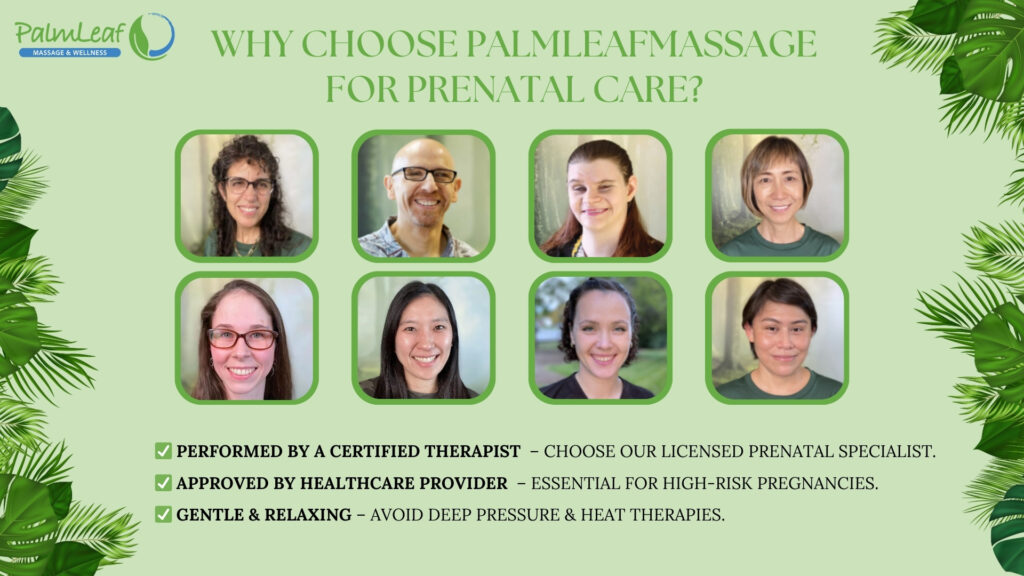
If you’re looking for a safe, professional, and relaxing prenatal massage, PalmLeaf Massage is a trusted name in pregnancy wellness. Our therapists are:
- Certified in prenatal massage and trained to accommodate the specific needs of pregnant women.
- Knowledgeable about trimester-specific precautions, ensuring a safe experience.
- Focused on providing relief from common pregnancy discomforts while promoting overall well-being.
PalmLeaf Massage understands the unique needs of expectant mothers and provides a comfortable, nurturing environment for relaxation and stress relief throughout pregnancy.


